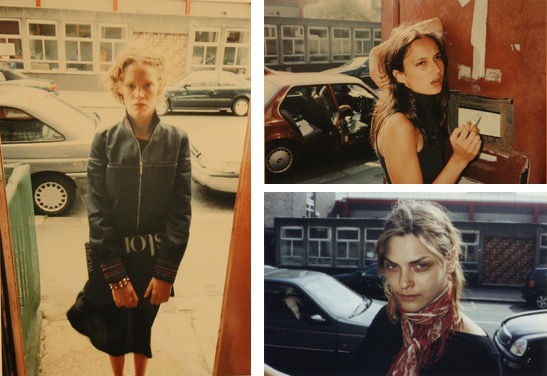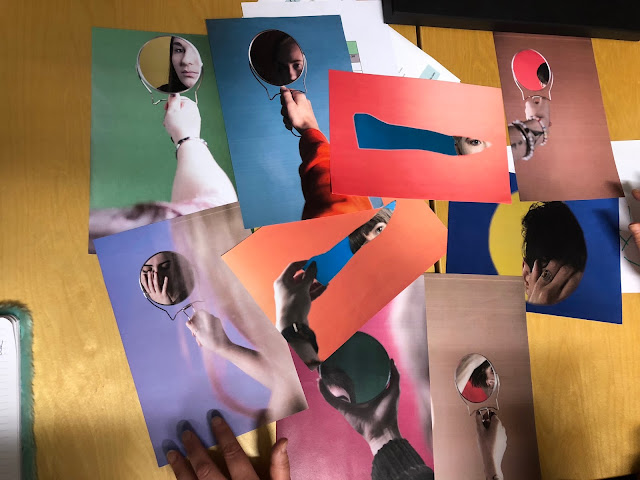Charlotte Jansen talk.
Today we had the opportunity to go to a lecture help by Charlotte Jansen, a journalist who specifies in art. The talk was based on her book called 'Girl on Girl', which focuses on female photographers and the way in which they represent women in a variety of different ways. Although I didn't think this talk related to my final major project, I wanted to go to it anyway because I thought it would be interesting to listen to someone talk about their work in front of such a large audience - the room in which the talk was held was pretty much full with only a few chairs spare in parts of the room.
I really enjoyed the talk and think it helped me out a lot more than I initially expected as she had a lot to say about photography and her views on the male gaze and femininity. Because she spoke about a lot of artists within her talk, I felt like I could use some of them to help develop my work in some way or use them to help with shoots I do alongside my university work.
Some artists she spoke about that interested me:
-Eva O'Leary
-Isabelle Wenzel
-Juno Calypso
-Jessica Yatrofsky
Eva O'Leary:
Looking into the idea of beauty and challenging the conventions that have been set, O'Leary's images aim to engage the audience "in a way that both seduce and challenge common perceptions of mainstream media" (http://www.thefader.com/2016/10/21/eva-oleary-photographer-interview). Her life growing up in Happy Valley, Pennsylvania had a major impact on her images because of how she was instantly exposed to society being male-dominated and the high expectations of women.
She tells The Fader that where she lived there was so much pressure put on women to look a certain way deemed acceptable by society and how these women had to model themselves into these perfect beings. It is not surprising that she features in Elephant magazine, who Jansen is Editor at Large at, due to her focus on the female gender and her imagery being so fresh and interesting. In the first image, it is clear to see feminism playing a large part in O'Leary's work due to the really clear split down the middle of the model's face separating it into two parts: makeup and natural. This clearly shows society's obsession with trying to make women look a certain way, to how they have to follow certain rules to be 'accepted'.
Isabelle Wenzel:
"The thing with gender is even if you don't want to talk about it, we talk about it all the time. So if I'm performing, people can't ignore the fact that I'm a female performer; this is the first thing they interpret." - Isabelle Wenzel.
These images are from the series 'Positions', and Isabelle (or sometimes the model she is photographing) bends her body into shapes to create images which have a silhouette style to them - what makes these images even more spectacular is how the self-portraits are taken only 10 seconds after pressing the shutter. This means that she has to move from behind the camera and pose herself however she wants to within a really short space of time. In these images, the face of the model doesn't matter - the pose of the body in an unusual way is the focus of these images. It looks at the stereotype of the female body within society and how this is often the first thing that is seen within an image, and by posing a body in this way and removing the face she is presenting the women as sexual objects - their face doesn't matter, only their body does.
Juno Calypso:
The series that was talked about in this talk was "The Honeymoon", in which Calypso booked out a honeymoon suite in a hotel and took self portraits. It follows previous projects of Calypso's entitled "Joyce I" and "Joyce II", which started out as a series of self-portraits of Calypso herself as a character called Joyce. These 2 projects focused on the fictional character Joyce as "a woman consumed by the laboured construct of femininity" (junocalypso.com/about) and then "The Honeymoon" is a continuation of these series.
For "The Honeymoon" project, she stayed at a romantic resort in America and used each room to show Joyce in different ways in her life; be it an act of desire or disappointment, or even in the middle of using a body mask to resemble metamorphosis. She looks into the idea of femininity in the way she uses props (for example the wigs she has used) and the way she portrays herself within the photographs - she is seen nude in some images representing perhaps her sexuality in the photographic medium, and then is seen to be in a mask in some of the images which could be used to represent women's constant pressure to become accepted by society.
Jessica Yatrofsky:
The project looked at within this talk was "I Heart Girl, a series of images focusing on real women, unadulterated and raw - some of the women in the images are naked without being objectified, and others are clothed without accentuating the model's gender. She states that "all of the subjects convey a vulnerability", which is shown clearly in the second image due to the nudity - she is presenting herself fully to the camera and ultimately anyone who views Yatrofsky's work. The first image presents vulnerability in a different way to the second image as the model is not nude - she presents herself with armpit hair which is often deemed unacceptable by society as a lot of people believe women should be hairless; this would offend some people and possibly cause anger towards the model. An interesting thing Yatrofsky said in the interview with Tish Weinstock for Vice is "It's an impossible task to de-sexualise women", which presents the question of whether or not women will ever be equal to men within society and specifically media or if it is always going to be something they will have to fight for.
I will leave this post on a quote that I think is very interesting and I think I may incorporate into my own work, to help develop and shape it:
"I'm inspired by people who are comfortable in their own skin, regardless of gender or shape." - Maya Fuhr.
I really enjoyed the talk and think it helped me out a lot more than I initially expected as she had a lot to say about photography and her views on the male gaze and femininity. Because she spoke about a lot of artists within her talk, I felt like I could use some of them to help develop my work in some way or use them to help with shoots I do alongside my university work.
Some artists she spoke about that interested me:
-Eva O'Leary
-Isabelle Wenzel
-Juno Calypso
-Jessica Yatrofsky
Eva O'Leary:
Looking into the idea of beauty and challenging the conventions that have been set, O'Leary's images aim to engage the audience "in a way that both seduce and challenge common perceptions of mainstream media" (http://www.thefader.com/2016/10/21/eva-oleary-photographer-interview). Her life growing up in Happy Valley, Pennsylvania had a major impact on her images because of how she was instantly exposed to society being male-dominated and the high expectations of women.
She tells The Fader that where she lived there was so much pressure put on women to look a certain way deemed acceptable by society and how these women had to model themselves into these perfect beings. It is not surprising that she features in Elephant magazine, who Jansen is Editor at Large at, due to her focus on the female gender and her imagery being so fresh and interesting. In the first image, it is clear to see feminism playing a large part in O'Leary's work due to the really clear split down the middle of the model's face separating it into two parts: makeup and natural. This clearly shows society's obsession with trying to make women look a certain way, to how they have to follow certain rules to be 'accepted'.
Isabelle Wenzel:
"The thing with gender is even if you don't want to talk about it, we talk about it all the time. So if I'm performing, people can't ignore the fact that I'm a female performer; this is the first thing they interpret." - Isabelle Wenzel.
Juno Calypso:
"Joyce II"
"The Honeymoon"
"The Honeymoon"
The series that was talked about in this talk was "The Honeymoon", in which Calypso booked out a honeymoon suite in a hotel and took self portraits. It follows previous projects of Calypso's entitled "Joyce I" and "Joyce II", which started out as a series of self-portraits of Calypso herself as a character called Joyce. These 2 projects focused on the fictional character Joyce as "a woman consumed by the laboured construct of femininity" (junocalypso.com/about) and then "The Honeymoon" is a continuation of these series.
For "The Honeymoon" project, she stayed at a romantic resort in America and used each room to show Joyce in different ways in her life; be it an act of desire or disappointment, or even in the middle of using a body mask to resemble metamorphosis. She looks into the idea of femininity in the way she uses props (for example the wigs she has used) and the way she portrays herself within the photographs - she is seen nude in some images representing perhaps her sexuality in the photographic medium, and then is seen to be in a mask in some of the images which could be used to represent women's constant pressure to become accepted by society.
Jessica Yatrofsky:
The project looked at within this talk was "I Heart Girl, a series of images focusing on real women, unadulterated and raw - some of the women in the images are naked without being objectified, and others are clothed without accentuating the model's gender. She states that "all of the subjects convey a vulnerability", which is shown clearly in the second image due to the nudity - she is presenting herself fully to the camera and ultimately anyone who views Yatrofsky's work. The first image presents vulnerability in a different way to the second image as the model is not nude - she presents herself with armpit hair which is often deemed unacceptable by society as a lot of people believe women should be hairless; this would offend some people and possibly cause anger towards the model. An interesting thing Yatrofsky said in the interview with Tish Weinstock for Vice is "It's an impossible task to de-sexualise women", which presents the question of whether or not women will ever be equal to men within society and specifically media or if it is always going to be something they will have to fight for.
I will leave this post on a quote that I think is very interesting and I think I may incorporate into my own work, to help develop and shape it:
"I'm inspired by people who are comfortable in their own skin, regardless of gender or shape." - Maya Fuhr.











Comments
Post a Comment